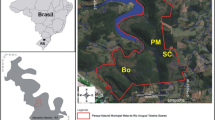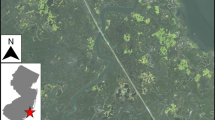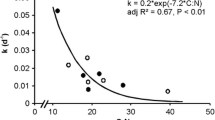Abstract
Wetlands of the Great Lakes region are increasingly dominated by invasive cattails (Typha angustifolia andTypha Xglauca) which form dense stands of live and dead biomass that may reduce plant diversity. We hypothesized that differences in plant litter accumulation explain cattail dominance under certain hydrologic regimes related to wetland hydrogeologic setting. We investigated cattail abundance, litter accumulation, and species density in three bayside wetlands hydrologically connected and three protected wetlands hydrologically isolated from Lake Ontario. Mean litter biomass was higher in bayside wetlands (1.7–2.6 vs. 0.4–1.2 kg/m2) and negatively related to species density (p = 0.004) in both settings. A litter addition experiment demonstrated that fallen litter negatively influenced seedling survival (p = 0.061) and species density (p = 0.024). Decomposition rates accounted only partially for higher overall litter accumulation in bayside wetlands. Growing season water levels in bayside wetlands tracked Lake Ontario levels and showed less variation than protected wetlands. More stable water levels and higher density of standing dead stems in bayside wetlands may limit litter fragmentation, resulting in greater litter accumulation. Thus, anthropogenic and natural factors affecting cattail litter production, fragmentation, and decomposition could influence species diversity in coastal wetlands.
Similar content being viewed by others
Literature Cited
Anderson, J. T. and L. M. Smith. 2002. The effect of flooding regimes on decomposition ofPolygonum pensylvanicum in playa wetlands (Southern Great Plains, USA). Aquatic Botany 74: 97–108.
Bailey, K. M. and B. L. Bedford. 2003. Transient geomorphic control of water table and hydraulic head reversals in a coastal freshwater peatland. Wetlands 23: 969–78.
Barlöcher, F. and N. R. Biddiscombe. 1996. Geratology and decomposition ofTypha latifolia andLythrum salicaria in a freshwater marsh. Archiv für Hydrobiologie 136: 309–25.
Battle, J. M. and S. W. Golladay. 2001. Hydroperiod influence on breakdown of leaf litter in cypress-gum wetlands. American Midland Naturalist 146: 128–45.
Bedford, B. L. 1996. The need to define hydrologic equivalence at the landscape scale for freshwater wetland mitigation. Ecological Applications 6: 57–68.
Bedford, B. L., M. R. Walbridge, and A. Aldous. 1999. Patterns in nutrient availability and plant diversity of temperate North American wetlands. Ecology 80: 2151–69.
Berendse, F. 1999. Implications of increased litter production for plant biodiversity. Trends in Ecology & Evolution 14: 4–5.
Berendse, F., M. Schmitz, and W. Devisser. 1994. Experimental manipulation of succession in heathland ecosystems. Oecologia 100: 38–44.
Boers, A. M. and J. B. Zedler. 2008. Stabilized water levels andTypha invasiveness. Wetlands 28: 676–685.
Bouchard, V. 2007. Export of organic matter from a coastal freshwater wetland to Lake Erie: an extension of the outwelling hypothesis. Aquatic Ecology 41: 1–7.
Brazner, J. C., N. P. Danz, A. S. Trebitz, G. J. Niemi, R. R. Regal, T. Hollenhorst, G. E. Host, E. D. Reavie, T. N. Brown, J. M. Hanowski, C. A. Johnston, L. B. Johnson, R. W. Howe, and J. J. H. Ciborowski. 2007. Responsiveness of Great Lakes wetland indicators to human disturbances at multiple spatial scales: a multi-assemblage assessment. Journal of Great Lakes Research 33 (Special Issue 3): 42–66.
Brinson, M. M., A. E. Lugo, and S. Brown. 1981. Primary productivity, decomposition and consumer activity in freshwater wetlands. Annual Review of Ecology and Systematics 12: 123–61.
Davis, C. B. and A. G. van der Valk. 1978. Litter decomposition in prairie glacial marshes. p. 99–113.In R. E. Good, D. F. Whigham, and R. L. Simpson (eds.) Freshwater Wetlands. Academic Press Inc., New York, NY, USA.
Dezozaya, I. Y. B. and J. J. Neiff. 1991. Decomposition and colonization by invertebrates ofTypha latifolia L. litter in Chaco cattail swamp (Argentina). Aquatic Botany 40: 185–93.
Facelli, J. M. 1994. Multiple indirect effects of plant litter affect the establishment of woody seedlings in old fields. Ecology 75: 1727–35.
Facelli, J. M. and S. T. A. Pickett. 1991. Plant litter — light interception and effects on an old-field plant community. Ecology 72: 1024–31.
Farrer, E. C. and D. E. Goldberg. 2009. Litter drives ecosystem and plant community changes in cattail invasion. Ecological Applications 19: 398–412.
Foster, B. L., T. L. Dickson, C. A. Murphy, I. S. Karel, and V. H. Smith. 2004. Propagule pools mediate community assembly and diversity-ecosystem regulation along a grassland productivity gradient. Journal of Ecology 92: 435–49.
Foster, B. L. and K. L. Gross. 1997. Partitioning the effects of plant biomass and litter onAndropogon gerardi in old-field vegetation. Ecology 78: 2091–2104.
Foster, B. L. and K. L. Gross. 1998. Species richness in a successional grassland: effects of nitrogen enrichment and plant litter. Ecology 79: 2593–2602.
Frieswyk, C. B. and J. B. Zedler. 2006. Do seed banks confer resilience to coastal wetlands invaded byTypha Xglauca? Canadian Journal of Botany 84: 1882–93.
Frieswyk, C. B. and J. B. Zedler. 2007. Vegetation change in Great Lakes coastal wetlands: deviation from the historical cycle. Journal of Great Lakes Research 33: 366–80.
Grace, J. B. 1993. The adaptive significance of clonal reproduction in angiosperms — an aquatic perspective. Aquatic Botany 44: 159–80.
Hill, N. M., P. A. Keddy, and I. C. Wisheu. 1998. A hydrological model for predicting the effects of dams on the shoreline vegetation of lakes and reservoirs. Environmental Management 22: 723–36.
Hollenhorst, T. P., T. N. Brown, L. B. Johnson, J. J. H. Ciborowski, and G. E. Host. 2007. Methods for generating multi-scale watershed delineations for indicator development in Great Lakes coastal ecosystems. Journal of Great Lakes Research 33: 13–26.
International Joint Commission. 2004. Lake Ontario St. Lawrence river regulation brochure. International St. Lawrence River Board of Control. http://www.islrbc.org/new-Version/ brochure.html.
Johnson, S. and E. Rejmankova. 2005. Impacts of land use on nutrient distribution and vegetation composition of freshwater wetlands in northern Belize. Wetlands 25: 89–100.
Johnston, C. A., B. L. Bedford, M. Bourdaghs, T. Brown, C. B. Frieswyk, M. Tulbure, L. Vaccaro, and J. B. Zedler. 2007. Plant species indicators of environmental condition in Great Lakes coastal marshes. Journal of Great Lakes Research 33 (Special Issue 3): 106–24.
Johnston, C. A., T. Brown, T. Hollenhorst, P. Wolter, N. Danz, and G. Niemi. 2009. GIS in support of ecological indicator development. p. 1095–1113.In Manual of Geographic Information Systems. American Society for Photogrammetry and Remote Sensing, Bethesda, MD, USA.
Jordan, T. E., D. F. Whigham, and D. L. Correll. 1990. Effects of nutrient and litter manipulations on the narrow-leaved cattail,Typha angustifolia L. Aquatic Botany 36: 179–91.
Keddy, P. A. and A. A. Reznicek. 1986. Great-Lakes vegetation dynamics — the role of fluctuating water levels and buried seeds. Journal of Great Lakes Research 12: 25–36.
King, R. S., C. J. Richardson, D. L. Urban, and E. A. Romanowicz. 2004. Spatial dependency of vegetation-environment linkages in an anthropogenically influenced wetland ecosystem. Ecosystems 7: 75–97.
Kuehn, K. A., M. J. Lemke, K. Suberkropp, and R. G. Wetzel. 2000. Microbial biomass and production associated with decaying leaf litter of the emergent macrophyteJuncus effusus. Limnology and Oceanography 45: 862–70.
Kuehn, K. A. and K. Suberkropp. 1998. Decomposition of standing litter of the freshwater emergent macrophyteJuncus effusus. Freshwater Biology 40: 717–27.
McNaughton, S. 1968. Autotoxic feedback in relation to germination and seedling growth inTypha latifolia. Ecology 49: 367–69.
Newman, S., J. Schuette, J. B. Grace, K. Rutchey, T. Fontaine, K. R. Reddy, and M. Pietrucha. 1998. Factors influencing cattail abundance in the northern Everglades. Aquatic Botany 60: 265–80.
Olde Venterink, H., N. M. Pieterse, D. M. Belgers, M. J. Wassen, and P. C. Ruiter. 2002. N, P, K budgets along nutrient availability and productivity gradients in wetlands. Ecological Applications 12: 1010–26.
Olde Venterink, H., R. E. van der Vliet, and M. J. Wassen. 2001. Nutrient limitation along a productivity gradient in wet meadows. Plant and Soil 234: 171–79.
Robertson, G. P., D. C. Coleman, C. S. Bledsoe, and P. Sollins. 1999. Standard soil methods for long-term ecological research. Oxford University Press, Oxford, England.
SAS. 2002. SAS Online Doc, Version 9. SAS Institute Inc, Cary, NC, USA.
Sayer, E. J. 2006. Using experimental manipulation to assess the roles of leaf litter in the functioning of forest ecosystems. Biological Reviews 81: 1–31.
Stevens, M. H. H., D. E. Bunker, S. A. Schnitzer, and W. P. Carson. 2004. Establishment limitation reduces species recruitment and species richness as soil resources rise. Journal of Ecology 92: 339–47.
Sydes, C. and J. P. Grime. 1981a. Effects of tree leaf litter on herbaceous vegetation in deciduous woodland. 1. Field investigations. Journal of Ecology 69: 237–48.
Sydes, C. and J. P. Grime. 1981b. Effects of tree leaf litter on herbaceous vegetation in deciduous woodland. 2. An experimental investigation. Journal of Ecology 69: 249–62.
Tilman, D. 1993. Species richness of experimental productivity gradients — how important is colonization limitation? Ecology 74: 2179–91.
Tulbure, M. G., C. A. Johnston, and D. L. Auger. 2007. Rapid invasion of a Great Lakes coastal wetland by non-nativePhragmites australis andTypha. Journal of Great Lakes Research 33 (Special Issue 3): 269–79.
Vaccaro, L. 2005. Patterns, mechanisms and ecological implications of cattail (Typha spp.) dominance in Great Lakes wetlands. M.S. Thesis. Cornell University, Ithaca, NY.
van der Valk, A. G. and C. B. Davis. 1978a. Primary production of praire glacial marshes. p. 21–37.In R. E. Good, D. F. Whigham, and R. L. Simpson (eds.) Freshwater Wetlands. Academic Press, Inc., New York, NY, USA.
van der Valk, A. G. and C. B. Davis. 1978b. Role of seed banks in vegetation dynamics of prairie glacial marshes. Ecology 59: 322–35.
van der Valk, A. G., J. M. Rhymer, and H. R. Murkin. 1991. Flooding and the decomposition of litter of four emergent plant species in a prairie wetland. Wetlands 11: 1–16.
Wilcox, D. A., S. I. Apfelbaum, and R. D. Hiebert. 1984. Cattail invasion of sedge meadows following hydrologic disturbance in the Cowles bog wetland complex, Indiana Dunes National Lakeshore. Wetlands 4: 115–28.
Wilcox, D. A., J. A. Ingram, K. P. Kowalski, J. E. Meeker, M. L. Carlson, X. Yichum, K. L. Holmes, and N. J. Patterson. 2005. Evaluation of water level regulation influences in Lake Ontario and upper St. Lawrence River coastal wetland plant communities. Final project report to the International Joint Commission, Washington, DC, USA and Ottawa, ON, Canada.
Wilcox, D. A., K. P. Kowalski, H. L. Hoare, M. L. Carlson, and H. N. Morgan. 2008. Cattail invasion of sedge/grass meadows in Lake Ontario: photo-interpretation analysis of sixteen wetlands over five decades. Journal of Great Lakes Research 34: 301–23.
Wilcox, D. A. and X. Yichun. 2007. Predicting wetland plant community responses to proposed water-level-regulation plans for Lake Ontario: GIS-based modeling. Journal of Great Lakes Research 33: 751–73.
Wisheu, I. C. and P. A. Keddy. 1992. Competition and centrifugal organization of plant-communities — theory and tests. Journal of Vegetation Science 3: 147–56.
Wolter, P. T., C. A. Johnston, and G. J. Niemi. 2006. Land use land cover change in the U.S. Great Lakes basin 1992 to 2001. Journal of Great Lakes Research 32: 607–28.
Woo, I. and J. B. Zedler. 2002. Can nutrients alone shift a sedge meadow towards dominance by the invasiveTypha Xglauca? Wetlands 22: 509–21.
Xiong, S. J., M. E. Johansson, F. M. R. Hughes, A. Hayes, K. S. Richards, and C. Nilsson. 2003. Interactive effects of soil moisture, vegetation canopy, plant litter and seed addition on plant diversity in a wetland community. Journal of Ecology 91: 976–86.
Xiong, S. J. and C. Nilsson. 1999. The effects of plant litter on vegetation: a meta-analysis. Journal of Ecology 87: 984–94.
Xiong, S. J., C. Nilsson, M. E. Johansson, and R. Jansson. 2001. Responses of riparian plants to accumulation of silt and plant litter: The importance of plant traits. Journal of Vegetation Science 12: 481–90.
Author information
Authors and Affiliations
Corresponding author
Rights and permissions
About this article
Cite this article
Vaccaro, L.E., Bedford, B.L. & Johnston, C.A. Litter accumulation promotes dominance of invasive species of cattails (Typha spp.) in Lake Ontario wetlands. Wetlands 29, 1036–1048 (2009). https://doi.org/10.1672/08-28.1
Received:
Accepted:
Issue Date:
DOI: https://doi.org/10.1672/08-28.1




